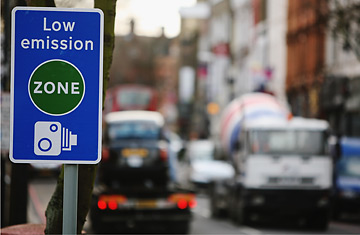
A low-emission-zone sign in London, England
Sometimes it's hard to muster enough critical detachment to report a subject fairly. Take the changes to London's congestion charging scheme that were unveiled at a ceremony in City Hall this morning. Ken Livingstone, the capital's two-term Labour Mayor — currently campaigning to win a third stint in May 1 elections — announced that from October onward, drivers of high-polluting vehicles will have to pay a punitive £25 or $50-a-day toll for city-center journeys. The chief focus of Livingstone's wrath are the four-wheel drive vehicles he calls "Chelsea tractors": shiny gas-guzzlers driven by affluent moms who drop off their little darlings at private schools and then cruise into town for their Botox appointments. The toll will be levied on any vehicle emitting more than 225g of carbon dioxide per kilometer (about 13 oz per mile) as well as any cars with engines larger than 3,000cc that were registered before March 2001.
The move toward charging for emissions is likely to prove popular with Livingstone's core supporters — blue-collar workers and a broad sweep of left-leaning metropolitan types concerned about climate change — as well as green campaigners across the world, who laud the congestion-charging scheme he first introduced in February 2003. The original daily $10 toll has been raised to $16, and the charging zone was extended westward last year. The mayor says that if a third of the 33,000 high-emissions cars daily entering central London continue to do so, the new scheme will generate a further $60 million to $100 million a year on top of the $240 million already raised by the congestion charge scheme, a chunk of which is reinvested in public transportation. Low-polluting vehicles such as the VW Polo Bluemotion or the Toyota Prius — coincidentally, the mayor's car of choice — will be exempt from paying any congestion charge.
This all sounds egalitarian in impulse and wonderfully eco-friendly (even if Livingstone's staff have placed a large bouquet of exotic flowers, fresh off a plane, on the desk where he will sign off on the CO2-saving scheme). So why am I less than enthused by the announcement? Full disclosure: sitting in my garage is the kind of car that the mayor wants kept off the streets.
It's not a Chelsea tractor and though a two-seater, it's certainly not the sort of sports car than a young man might buy to enhance his pulling power. Built in 1975, this Mercedes SL 350 convertible is a little rusty here and there. The soft top takes years of practice to manipulate into position and the optional hard top has to be lowered on or lifted off with a hefty winch. Painted a delicate golden color called Champagne, the car is a thing of beauty to me. And it promised to be a joy forever, as it sailed through its annual safety checks year after year.
Yes, its V8 engine guzzles a lot of gas. But the car is used very little, only for occasional necessary short trips and the odd journey for recreational purposes. The advice I'd received from green experts is that it's preferable to keep an old car going for as long as possible. Each new car requires energy and materials to produce, equivalent to some 15% of the total lifetime emissions of a car in regular use.
Sian Berry, who is challenging Livingstone in the mayoral race on behalf of the Green Party but backing him on this initiative, thinks she spots a solution to my problem. "If you hardly drive your car, then a £25 congestion charge might be worth living with rather than getting rid of the car," she says. "People are very good at unconsciously cutting down on their driving, when there's a fuel crisis for example."
There's another twist, I tell her. I live inside the congestion charging zone, so will be expected to pay $50 every time I take the car out of the garage on a weekday. That's almost the cost of a minicab journey to Heathrow. Or a pizza dinner. I'll have to swap the Mercedes for a new car and my carbon footprint will get bigger. "If you hardly drive it, that's a really good point," she says. "There are people like you, but hopefully not too many. People with very old, well-looked-after Mercedes are probably not the target of this, but we have to put the measures in somewhere."
That's a fair comment. So is there anyone else rash enough to criticize this planet-saving scheme? Step forward Livingstone's chief challenger Boris Johnson, the Conservative candidate for mayor. He responded to Livingstone's announcement with a statement attacking the "appalling state of the transport system" and suggesting that the new charge will hit poorer families who can't afford to exchange their old bangers for new, clean cars. "In effect, the mayor has just given the green light for richer people to buy smaller cars and enter the zone for free while families who struggle with one big car are left feeling the pinch."
A $50 charge probably won't deter London's superrich from tooling down Park Lane in their Lamborghinis, and Johnson is right that affluent households may just add a brace of low-emissions cars to their private transport options. A small increase in traffic as people take advantage of the exemption is unlikely to worry the Mayor, whose main aim is to wean people off private cars and onto buses, tubes and bikes. He says the scheme will be monitored and the exemption repealed if "hordes of people with a malignant turn of mind rush out to buy [low-emissions] cars just to annoy me." If he gets his third term in May, he adds, he'll bring in "increasingly punitive measures for those who disregard the future for our children." Some of us are already hurting.
